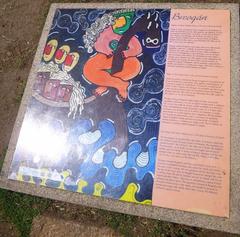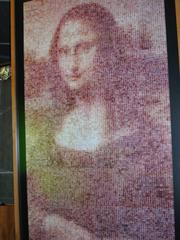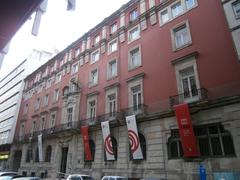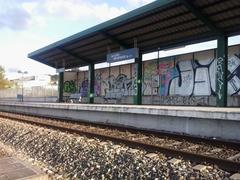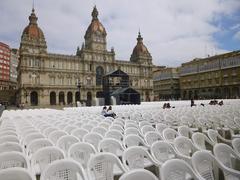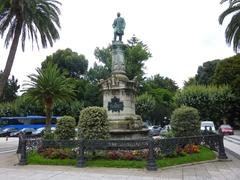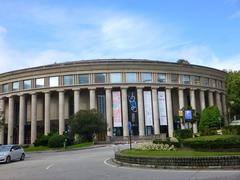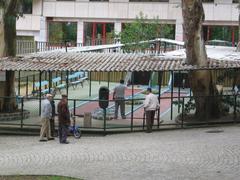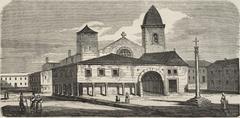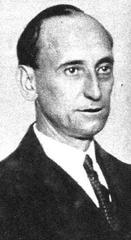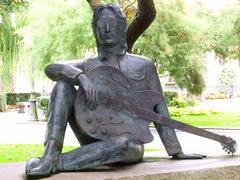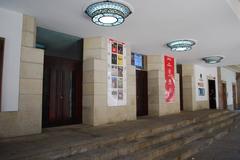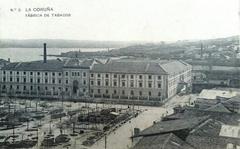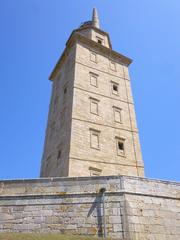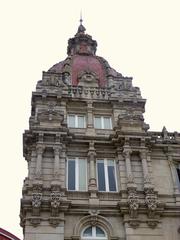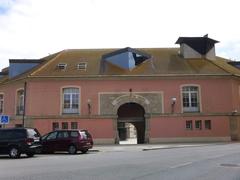
Plaza de Toros of La Coruña: Visiting Hours, Tickets, and Historical Significance
Date: 04/07/2025
Introduction: History and Cultural Importance
Nestled in the vibrant coastal city of A Coruña, Spain, the Plaza de Toros has served as a prominent symbol of tradition and urban evolution since its construction in 1885. Originally built as a robust bullfighting arena, it quickly became a center for both taurine artistry and wide-ranging social events, mirroring the region’s historical attachment to Spanish bullfighting and community festivities. Although the original bullring has since been demolished and replaced by the modern Coliseum da Coruña, its legacy remains deeply ingrained in the city’s collective memory and continues in the form of diverse events held at the Coliseum today.
This guide explores the origins, architectural evolution, and cultural role of the Plaza de Toros, providing practical information for visitors, including current venues, event schedules, ticketing, and accessibility. Whether you are a history enthusiast or a cultural explorer, this resource equips you with the knowledge to engage with A Coruña’s unique heritage. For further updates on events or detailed schedules, visit official platforms or download the Audiala app (El Ideal Gallego, Tomaticket, Spain Traveller, Catedral de Toledo).
Table of Contents
- Introduction: History and Cultural Importance
- Early Bullrings in A Coruña
- Construction and Features of the Plaza de Toros (1885)
- Architectural Evolution
- The Plaza’s Cultural and Social Role
- Ownership and Urban Development
- Decline and Demolition
- Legacy and the Modern Coliseum da Coruña
- Visiting Information: Hours, Tickets, Accessibility
- Coliseum da Coruña: Modern Venue Highlights
- Events and Experiences at the Coliseum
- Visitor Tips and Nearby Attractions
- Frequently Asked Questions (FAQ)
- Conclusion
- References
Early Bullrings in A Coruña
Bullfighting’s presence in A Coruña dates back centuries, with early events held in temporary wooden structures at sites like Plaza Real (now Plaza de Azcárraga), Corralón, and Campo de Marte. These provisional arenas, constructed from wood, showcased the improvisational spirit of early Galician bullfighting (El Ideal Gallego).
Construction and Features of the Plaza de Toros (1885)
Responding to the growing popularity of bullfighting, A Coruña inaugurated its first permanent bullring in 1885, designed by architect Juan de Ciórraga. The venue could seat 10,000 people and featured robust masonry walls, pine wood interior structures, tiered seating with wrought iron railings, and direct, independent entrances for all seating areas. The practical design prioritized capacity and safety over ornamentation, distinguishing it from the more ornate bullrings elsewhere in Spain (El Ideal Gallego, Quincemil).
Architectural Evolution
The Plaza de Toros underwent several modifications:
- 1903: Façade redesigned; seating expanded to over 12,000.
- 1922: Installation of electric lighting for evening events.
- 1991: Major renovations to modernize and expand facilities, ensuring compliance with contemporary standards (Catedral de Toledo).
These changes reflected both enduring interest in bullfighting and a drive to keep the venue relevant for broader uses.
The Plaza’s Cultural and Social Role
Known as “La Paloma,” the Plaza de Toros was a social and cultural epicenter in A Coruña. Beyond hosting major bullfights, including the renowned Feria del Atlántico and charitable Corrida de la Beneficencia, it was a venue for concerts, sporting events, political gatherings, and theater. During the Spanish Civil War, it even served as a refuge for locals (Catedral de Toledo). The venue’s flexibility cemented its role as a communal gathering place (Quincemil).
Ownership and Urban Development
Ownership of the bullring changed hands several times, reflecting shifts in urban priorities:
- 1893: Sold to Juan Mera Ramos and partners.
- 1945: Acquired by Sociedad Urbanizadora Coruñesa S.A., with intentions for redevelopment (El Ideal Gallego).
Its central location in the Ensanche district influenced the evolution of surrounding neighborhoods, blending residential, industrial, and leisure spaces (Quincemil).
Decline and Demolition
By the late 20th century, shifting public attitudes and ethical debates over animal welfare led to decreased support for bullfighting, particularly in Galicia. Proposals for demolition surfaced as early as the 1940s, and the original bullring was ultimately demolished. The decision, influenced by animal rights activism and urban development goals, marked the end of an era and the start of a new chapter for communal spaces in A Coruña (Catedral de Toledo).
Legacy and the Modern Coliseum da Coruña
While the historic Plaza de Toros no longer stands, its memory endures in A Coruña’s culture. The site evolved into the Coliseum da Coruña, inaugurated in 1991, which now hosts concerts, sports, and festivals for local and international audiences, continuing the tradition of communal celebration in a modern format (Catedral de Toledo).
Visiting Information: Hours, Tickets, Accessibility
Hours and Tickets
The original Plaza de Toros is no longer accessible, but its legacy is preserved at the Coliseum da Coruña. Venue hours vary by event; typically, doors open 1–2 hours prior to scheduled activities. Tickets can be purchased online from authorized platforms or at the box office. Advance booking is recommended during popular festivals (Tomaticket).
Accessibility
The Coliseum da Coruña is equipped for full accessibility, featuring ramps, elevators, and reserved seating for visitors with disabilities (Tomaticket).
Travel Tips & Nearby Attractions
- Best times to visit: During annual festivals in August and September.
- Transport: Accessible via city buses, taxis, and pedestrian-friendly routes.
- Nearby attractions: Tower of Hercules, María Pita Square, and A Coruña’s Old Town.
Coliseum da Coruña: Modern Venue Highlights
The Coliseum da Coruña, designed by Salvador Pérez Arroyo and collaborators, showcases contemporary architecture with a circular, adaptable interior. With a maximum capacity of around 11,000, it accommodates concerts, sports, exhibitions, and fairs (Tomaticket, Bandsintown). Modern amenities include VIP areas, advanced acoustics, climate control, and comprehensive accessibility. Its location at Rúa Francisco Pérez Carballo, 2, ensures convenient access.
Events and Experiences at the Coliseum
Since its transition from bullring to cultural center, the Coliseum has hosted a wide range of events, including performances by Marc Anthony, Shakira, Lionel Richie, and more. It is also home to Leyma Coruña basketball games, ice shows, and community festivals (El Ideal Gallego). Guided tours are sometimes available by appointment, and VIP packages offer exclusive experiences.
Visitor Tips and Nearby Attractions
- Weather: The Coliseum’s covered design ensures year-round comfort, regardless of A Coruña’s Atlantic climate.
- Dining & Amenities: On-site food, merchandise, and restrooms available.
- Safety: The venue maintains strict security and health protocols.
Combine your visit to the Coliseum with exploration of the Old Town, Tower of Hercules, and local dining for a complete cultural experience (This Remote Corner).
Frequently Asked Questions (FAQ)
Q: Can I visit the original Plaza de Toros?
A: The original bullring was demolished. The site is now home to the modern Coliseum da Coruña.
Q: What are the Coliseum da Coruña’s visiting hours?
A: Hours vary by event; typically, doors open 1–2 hours before start time. Check the official calendar.
Q: How do I buy tickets?
A: Purchase tickets online via Tomaticket, Servitoro, Bandsintown, or at the box office.
Q: Is the Coliseum accessible?
A: Yes, the venue provides ramps, elevators, and accessible seating.
Q: What events can I attend?
A: The Coliseum hosts concerts, sports, fairs, and occasional bullfighting events during festival seasons.
Conclusion
The story of the Plaza de Toros in A Coruña reflects the city’s ongoing dialogue between tradition and modernity. While the original bullring has vanished, its spirit persists in the dynamic cultural life of the Coliseum da Coruña and throughout the city’s historical sites. Visitors can immerse themselves in the city’s rich heritage by attending events, exploring nearby attractions, and appreciating the evolving role of communal spaces in Spanish culture.
For up-to-date event information, ticketing, and visitor resources, consult official platforms and consider downloading the Audiala app for exclusive content and timely updates.
References
- El Ideal Gallego
- Tomaticket
- Spain Traveller
- In Review Online
- La Voz de Galicia
- Servitoro
- Quincemil
- Catedral de Toledo
- Bandsintown
- Wikipedia
- La Voz de Galicia - 2023
- This Remote Corner





